
Бесплатный фрагмент - A communicative approach in teaching English
Dear collegues!
This guide is intended to be used by the teacher of English to make their lessons more effective, creative and teach students to communicate and use English in real life.
I have included all the practical aspects of a communicative approach, its main ideas, methods and techniques and provided the examples of tasks for different levels into this brochure.
I have also attached the examples from my own teaching practice which I successfully apply at the lessons.
You can use them and create your own tasks!
The communicative approach. Its principles
The main approaches to teaching English at school today are grammar-translation and communicative ones.
Most teachers use a grammar-translation method the essence of which is to translate everything into Russian, explain grammar in Russian and do exercises which we call «drills» to practise your language skills.
The drawbacks of such an approach are clear to everyone:
— the students do not get used to speaking English as the teacher and they mainly speak Russian at the lessons,
— the students memorise and learn everything by heart without understanding how to use these constructions in real life,
— the language barrier is large as they don’t communicate and don’t pay much attention to speaking and listening to native speakers.
Nowadays the communicative approach has spread largely in schools, and advanced teachers prefer using it.
Its undisputable advantages are:
— lifelike situation at the lessons,
— the creation of the speaking environment,
— the reproduction of all new structures into speech,
— the practical use of the language.
The principles of the communicative approach are:
— imitating real speaking environment,
— speaking English all the time,
— emerging students into communicative situations,
— encouraging students to talk,
— concentrating more on the speech,
— teaching grammar in context,
— being positive, creative and democratic with the students.
Your first goal is imitating real speaking environment by means of creating communicative situations.
Here are some examples.
Situation 1.
Students — pre-schoolers
Topic: «Toys»
The aim of the task — to remember the words and the phrase: «give me…»
The students have the cards with the toys, they need to complete the full row: the teacher puts the row on the board: a ball, a doll, a car, a soldier. Each student has a card with one toy missing. They need to ask a teacher: «Give me a … (missing card) ” and complete their row.
Situation 2:
Students — adults (elementary)
Topic: «Daily routines»
The aim of the task — to practise Present Simple statements, the question «What time do you..?», remember daily routines.
The students are to make a poll. They can see cards with everyday actions on the board. They ask their partners questions such as «What time do you … (get up)?» and write down their answers on the blank. Then they need to tell the class about their partner: «Mike gets up at 6 a.m., he has breakfast at 8 am…»
The communicative situation imitates real life conditions provoking students to talk.
If these are small kids, it is enough to imitate primitive situations with short simple phrases and sentences. If the students are grown-ups, you need to choose relevant topics and interesting circumstances.
The second important principle is to speak Engish at the lessons. It is difficult to make it understandable for young learners and beginners what to do speaking only English. The tips here may be:
— simplifying the lenguage without using difficult words and structures,
— pacing and gradual presentation of the material,
— pre-tasks and introductory exercises,
— creativity and positive atmosphere.
The students are emerged into the comunictive situations through such tasks as:
— brainstorming,
— speaking and vocabulary games,
— role plays,
— discussions,
— expressing your opinion,
— reacting to relevant issues.
As for the importance of grammar, it is not diminished in a communicative approach but represented in a communicative context. The students should express their thoughts using new grammar structures and not just doing exercises and drills. Thus, we concentrate more on speech than on anything else practising a communicative approach.
The communicative methods exclude concentration on students’ mistakes and writing out and correcting everything you hear, as well as translating all the words and constructions. It provides the material in real situations and makes it possible for the students to immediately use new vocabulary and grammar in their speech.
A lesson plan
Productivity at the lesson is achieved if it is well-structured and organised. The activities at the lesson should be logically connected and refer to one lexical and grammatic topic. The amount of activities at the lesson differs from 5 to 10 depending on the age and level of students.
A good lesson structure should include:
An ice-breaking task. It should be 5—7 minutes in the beginning of the lesson to make students involved in the process and to introduce a new topic:
— questions — answers,
— a video \ song with gap-filling and eliciting the topic of today’s lesson,
— cards with actions to show your partner, choose and guess the word (from new words or pictures),
— checking homework (may be done before an ice-breaker).
The introdution of a new topic. About 10 minutes.
— Vocabulary is introduced through cards, images, definitions, games.
— Grammar is introduced in the context through games, questions \ answers, composing sentences under the model, finding structures in the text and eliciting the meaning.
Pre-tasks. 5 minutes: tasks to pre-teach the vocabulary, structures or ideas expressed in the following reading, listening, a video. Among the tasks there may be:
— questions,
— discussion «for \ against»,
— games,
— guesses what the topic is,
— finding opposites \ synonyms, etc.
The main task. Practising new vocabulary and grammar. 10—15 minutes:
— reading, listening or a video can be the main task representing new material including the topic, vocabulary and grammatic structures,
— drilling (filling in the gaps, matching tasks, composing sentences putting words in the correct order, finding words with the given meaning, choosing between several options, multiple choice tasks) can be done to check the understanding of the vocabulary and grammar from the main task.
Post-tasks. 5—10 minutes.
The students should reproduce what they have read, listened to, watched, — and speak on the topic, compose dialogues (even using the samples), express their opinion, make a role play, agree or disagree, etc.
The final part. 3—4 minutes.
— Mistakes correction: on the board the main mistakes made by the students are written down.
— The home task is also written down on the board and explained by a teacher if necessary.
Here is the example of a lesson plan. It’s convenient to complete a chart with it for better comprehension.
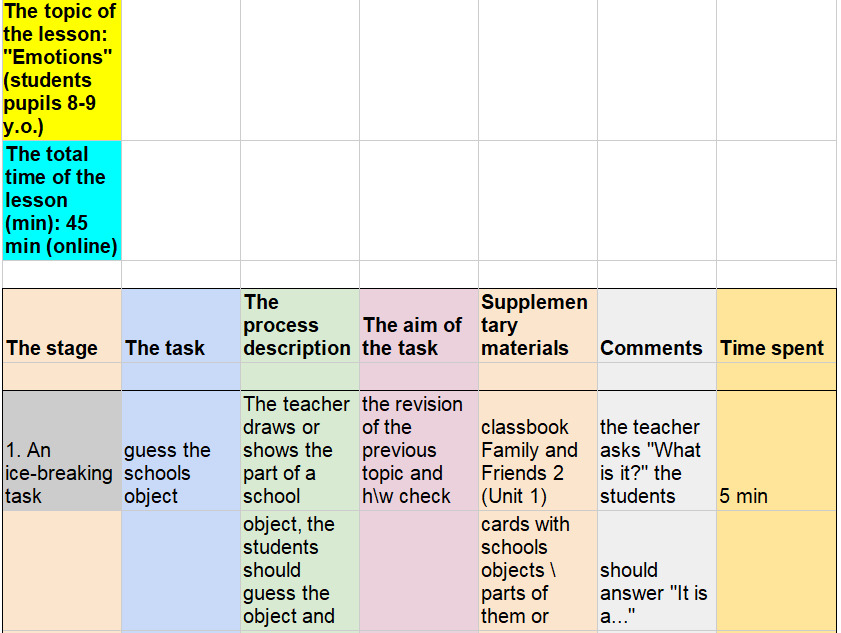

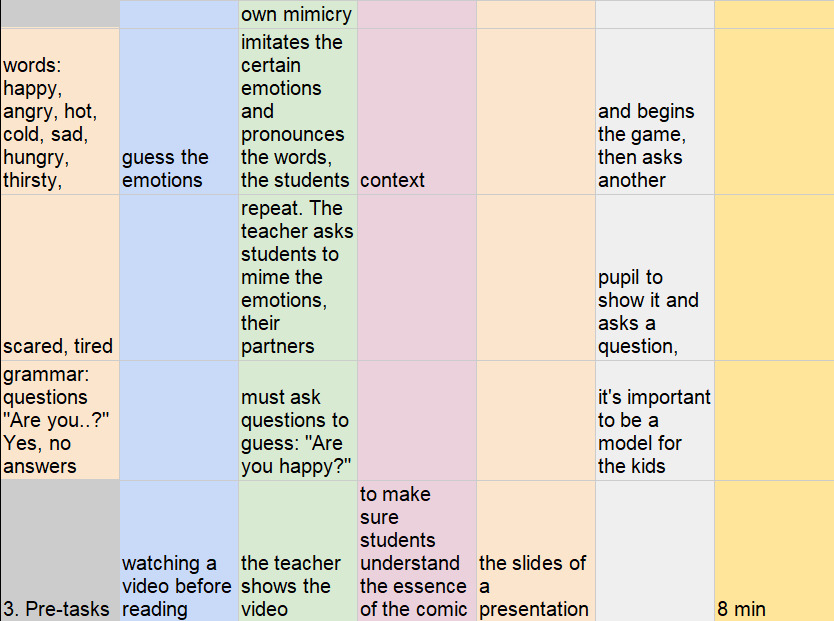
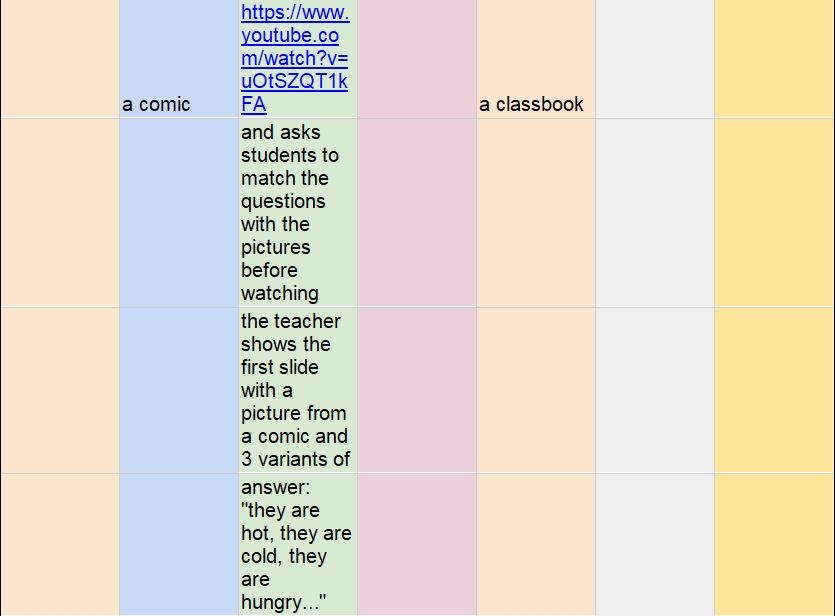

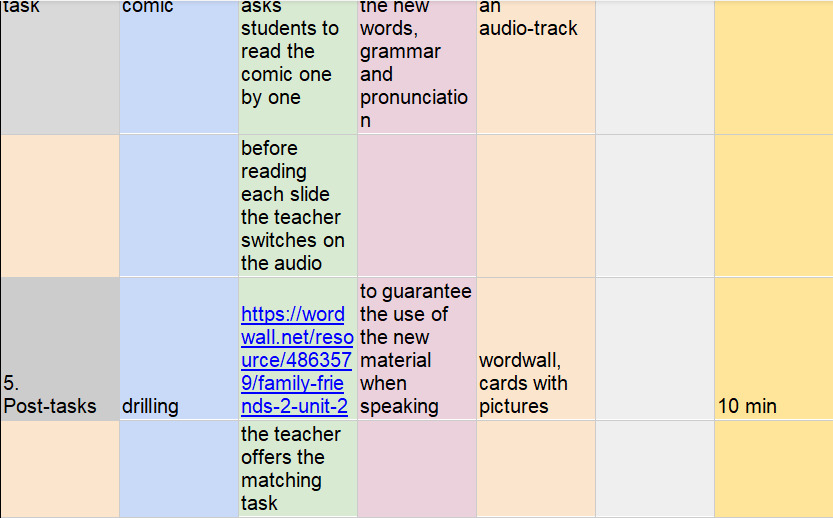
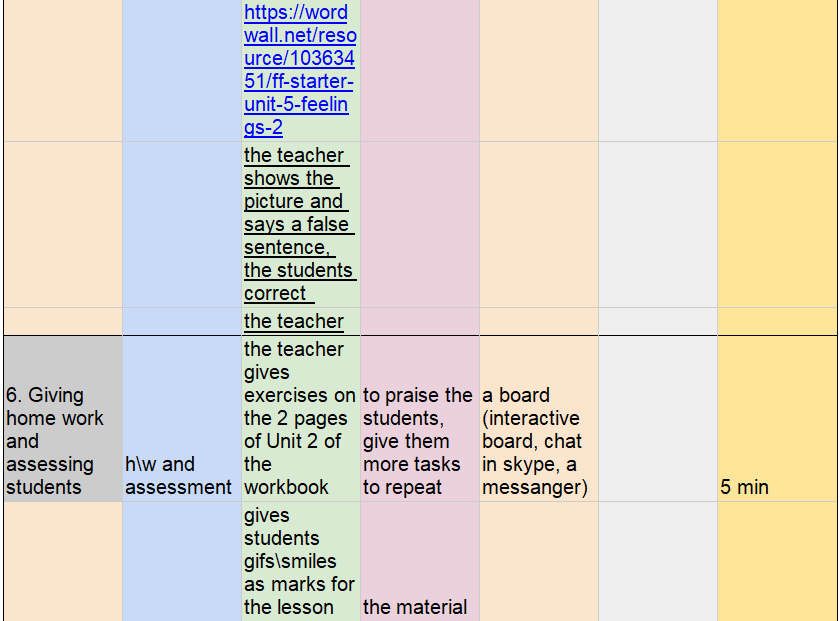
How to speak English only
What typical problems does a teacher have to tackle while speaking only English at the lesson?
— Speaking English with young learners who are not prepared and can’t understand any information yet.
— With beginners the problem is the same as with young learners.
— Reacting to their Russian — students tend to speak Russian when they know their teacher is not a native speaker.
— Simplifying — a teacher needs to learn how to simplify their speech to make it comprehensive for the students of low levels.
— Pacing — a gradual presentation of the material.
— Using supplementary materials — there are a lot of them to visualise new vocabulary.
The solutions for these problems may be:
For young learners:
— prepare the materials supporting new words visually: cards, images, presentations, toys, puppets.
— Use a lot of gestures and facial mimicry, show actions with your movements, don’t be shy to act and play together with them.
— Try to use simple language, do not paraphrase commands (let’s say together — should always be the same, don’t change it into «let’s repeat, or repeat after me…»)
— Let them touch, watch and move a lot while studying, repeat the words you’ve said and keep their own tempo, don’t accelerate them much.
For beginners (teenagers \ adults):
— use a screen-demonstration (if online) or handouts and board actively (if off-line).
— Visual support is also very important, provide the video with short dialogues, repeat them after the audio-recordings, use images for new words.
— Simplify your language: speak distinctively and slowly, repeat and paraphrase your sentences if they fail to understand them.
— The body language is as important as visualization.
Reacting to students using their native language instead of English:
— if they ask something or say something in Russian, react and answer in English, ask them to repeat their question in English writing down or saying the words they didn’t know.
— If they ask you to say something in Russian, the way it works is to show them the picture of the word on the Internet (if online) or paraphrase what you have said or give them the synonymous row.
— The worst thing is to be overprotective and translate everything you said into Russian for them. They should get used to think in English and guess the meanings of unknown words through the context.
Simplifying:
— if you work with lower levels, you will need to be precise and use the structures that they know when giving instructions.
— The images are used to give them the idea of what the words on the list mean. You should visualise as more as possible.
— If the task seems too difficult for the level, you can give additional prompts and adapt the material for the students to make it less elaborate.
Pacing:
— give a new material gradually, don’t hurry up.
— Some topics can be divided into parts.
E.g. Present Perfect is better to divide into working with each meaning during one or even two lessons at the same time enriching the vocabulary.
— Make sure there isn’t a big gap between the spoken and grammatic material. You should pay more attention to the involvement of students into talking, but compose the material so that they could practise grammar structures while talking too.
— E.g. Present Perfect is well understood in the context of such a topic as «Travelling» because you can ask questions with «Have you ever been..?» and others about their experience.
Supplementary materials:
— pictures \ online images,
— presentations (online),
— apps and programmes (learning apps, kahoot, bamboozle, wordwall, quizlet) — online and at the computer,
— printed handouts,
— audio \ video,
— cards (not only with images, with roles, tasks…),
— toys, etc.
They are needed for visualisation, games, speaking practice and they help you involve students in the communicative process at the lesson.
Control at the lesson
What should a teacher control at the lesson? Not every movement of the students’ tongue and immediately correct every mistake as someone may think! But the following points:
— the progress of the students: for that there should be the initial and final testing (at the beginning and at the end of the level). You can test students orally, through written tasks, giving the overview of the progress, praising and indicating what students can do that they couldn’t do before.
— Home work: briefly checking the main aspects, e.g.just the words inserted in the sentences — not the whole sentence to read, and partially through the tasks at the next lesson. That is when the teacher gives the same kind of exercise (with the same vocabulary or grammar they have already had at the previous lessons and at home to practise), it is clear that the student understood the task and did everything at home if they give correct answers. You can briefly check homework together, but no more than 5 minutes at the beginning of the lesson or if it refers to any other part of the lesson — in the middle or even by the end of it.
— The understanding of the text or listening: through asking questions, brainstorming, giving extra words and phrases. It is essential to correct frequent mistakes after the task, at the end of the lesson or by means of asking other students to correct their classmate.
What is the bad way to expose control over all these aspects?
— Don’t prompt each word. Give a student the chance to speak out. Sometimes more time is needed for a person to concentrate.
— The teachers tend to be impatient and sometimes faster than the student to answer the question they themselves ask. It is not good to do this way.
— Interrupting students all the time to add something to correct mistakes. The students can lose their thought or become shy and even start being afraid of making frequent mistakes thus adapting a speech barrier.
— Spending the whole lesson to check a huge home task is also a bad idea for a teacher. If the student asks you to give them more tasks, it is Ok, but try not to waste time at the lesson checking all that stuff. Agree on the additional time for you to check and give the students feedback. Otherwise you will not have time for a new topic at the lesson.
— Giving a test, dictations and progress control every lesson. You’d better do it in the beginning, in the middle and at the end of the course to make sure the students are on their way to progress. If the test results show you something has gone wrong and nobody or almost nobody understood particular things, you need to turn back to them and create more activities for their practice. The tests are mainly indicators of the students’ progress for a teacher but they shouldn’t be written at every lesson to bother students and give them stress.
The effective use of the resources and techniques at the lesson
The resources and techniques you use may differ depending on the format of your lessons: whether they are off-line or on-line.
As for off-line resources recommended to assist in teaching according to communicative principles, they are:
— books: class books, activity books, grammar books: they are the main sources of information and program at your lessons, they are the crutch for you to teach,
— cards: images and words, puzzles, colored pages: they are needed for visualisation and creative atmosphere at the lesson,
— games: board-games, oral games, game rugs, cubes, toys, puppets: there are a lot of variants both for kids and adults,
— handouts: prepared yourself, supplementary: you may use them for different tasks giving instructions, additional information to the students,
— a board \ projector: active at every lesson. The teacher needs to put cards, words, write different examples on it when necessary.
As for on-line resources, what you can use is:
— screen demonstration: it should work for visualization instead of the board,
— An interactive board: optional, (chat with putting down and saving main and essential information may be used instead).
— Web-resources: https://wordwall.net/, https://learningapps.org/, https://www.baamboozle.com/, https://kahoot.com/, https://quizlet.com/ru (for games, words, grammar, speaking, pre\post tasks instead of handouts, drills and cards) and other web-sites.
Here are some examples of the tasks on these web-sites:
— the task for pre-schoolers. The aim is to practise adjectives and answer the question «Who is big?… Who is tall?» — «The elephant is big...The giraffe is tall.»
Бесплатный фрагмент закончился.
Купите книгу, чтобы продолжить чтение.
